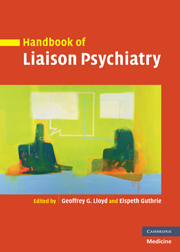Book contents
- Frontmatter
- Contents
- List of contributors
- Preface
- Part I Basic skills
- Part II Common psychiatric problems across the general hospital
- 7 Functional somatic syndromes
- 8 Alcohol problems in the general hospital
- 9 Drug misuse in medical patients
- 10 Sexual problems in medical patients
- 11 Suicide and deliberate self-harm
- 12 Delirium
- 13 Childhood experiences
- Part III Working with specific units
- Part IV Treatment
- Part V Different treatment settings
- Index
- References
7 - Functional somatic syndromes
from Part II - Common psychiatric problems across the general hospital
Published online by Cambridge University Press: 10 December 2009
- Frontmatter
- Contents
- List of contributors
- Preface
- Part I Basic skills
- Part II Common psychiatric problems across the general hospital
- 7 Functional somatic syndromes
- 8 Alcohol problems in the general hospital
- 9 Drug misuse in medical patients
- 10 Sexual problems in medical patients
- 11 Suicide and deliberate self-harm
- 12 Delirium
- 13 Childhood experiences
- Part III Working with specific units
- Part IV Treatment
- Part V Different treatment settings
- Index
- References
Summary
Definition and terminology
The ‘functional somatic syndromes’ (FSS) refer to a number of related syndromes that have been characterized by the reporting of somatic symptoms and resultant disability rather than on the evidence of underlying conventional disease processes. Many FSS have been described. Some of these, such as irritable bowel syndrome, are well recognized within mainstream medicine but some, such as sick-building syndrome are not; all however share the feature of a disconnection between subjective symptomatology and objective biomedical pathology. Most medical specialities have at least one FSS (see Table 7.1), whilst FSS on the periphery of mainstream medicine continue to capture public attention. The symptoms required for the diagnosis of a FSS are usually ‘medically unexplained’, that is physical symptoms for which there is no adequate organic explanation. Chronic fatigue syndrome, irritable bowel syndrome and fibromyalgia have been more extensively researched than most other FSS which has led to specific pathophysiological mechanisms being advanced for each. Nevertheless, as yet no specific explanation is convincing and it remains the case that the similarities between the different FSS are sufficiently striking for there to be a compelling case for considering them together (Barsky & Borus 1999; Wessely et al. 1999).
Conceptual issues
Whilst the diagnostic criteria for FSS (where they exist) have usually been produced by the medical specialities, the psychiatric classification systems of the International Classification of Disease (ICD-10) or Diagnostic and Statistical Manual of Mental Disorders (DSM-IV) exist in parallel, although it might be fairer to say in conflict.
Keywords
- Type
- Chapter
- Information
- Handbook of Liaison Psychiatry , pp. 125 - 148Publisher: Cambridge University PressPrint publication year: 2007
References
- 1
- Cited by



